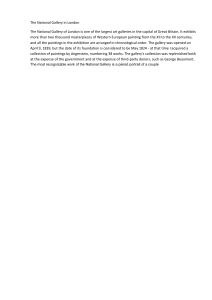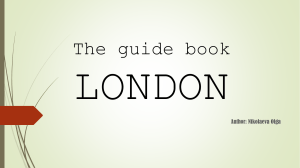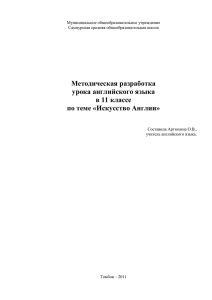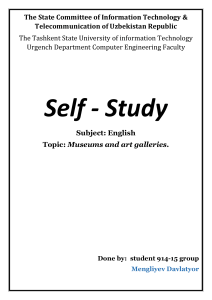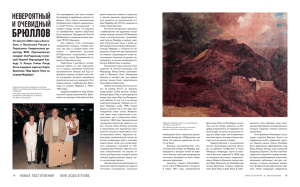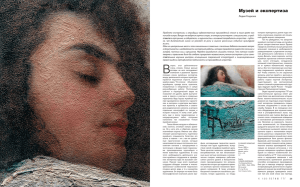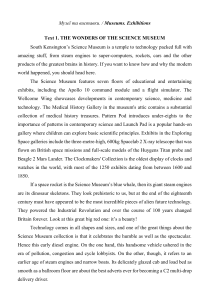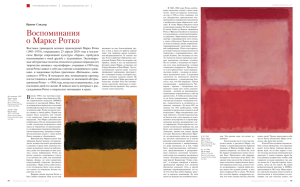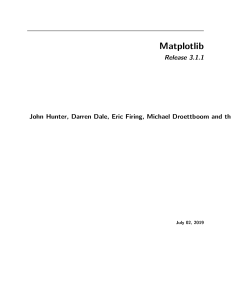The National Gallery
реклама
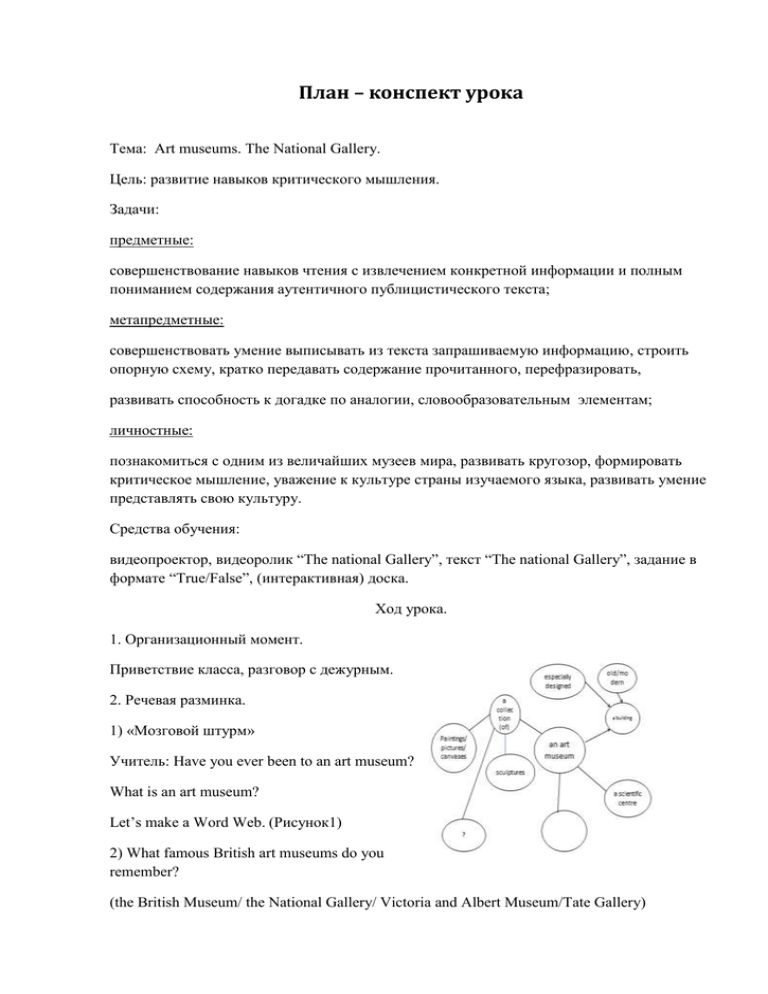
План – конспект урока Тема: Art museums. The National Gallery. Цель: развитие навыков критического мышления. Задачи: предметные: совершенствование навыков чтения с извлечением конкретной информации и полным пониманием содержания аутентичного публицистического текста; метапредметные: совершенствовать умение выписывать из текста запрашиваемую информацию, строить опорную схему, кратко передавать содержание прочитанного, перефразировать, развивать способность к догадке по аналогии, словообразовательным элементам; личностные: познакомиться с одним из величайших музеев мира, развивать кругозор, формировать критическое мышление, уважение к культуре страны изучаемого языка, развивать умение представлять свою культуру. Средства обучения: видеопроектор, видеоролик “The national Gallery”, текст “The national Gallery”, задание в формате “True/False”, (интерактивная) доска. Ход урока. 1. Организационный момент. Приветствие класса, разговор с дежурным. 2. Речевая разминка. 1) «Мозговой штурм» Учитель: Have you ever been to an art museum? What is an art museum? Let’s make a Word Web. (Рисунок1) 2) What famous British art museums do you remember? (the British Museum/ the National Gallery/ Victoria and Albert Museum/Tate Gallery) 3) Fill in the 1st column in the table. What do you know about the National Gallery? I know I have known I’d like to know 4) Now you’ll watch a short video. [1] (Приложение 1) (Сюжет длится 1,53 мин.) 4) Why have we watched this video film? (В случае затруднения учитель задает наводящие вопросы) Отвечая на вопрос, учащиеся формулируют цель урока: We are going to learn something interesting about the National Gallery. /We’ll know about the collections. I think we’ll know more about the British culture and we’ll be more cultural people. Учитель: What are the language tasks? Ученики: We must read the information/We’ll speak about the the National Gallery/We must learn to speak, read, write about an art museum. 3. Основная часть. 1) Работа с текстом “The National Gallery”[2] (Приложение 2) Работа проходит в группах, организованных по уровню обученности. Группа 1: Find the international words in the text and words easy to understand without translation. Find attributes to those words. Группа 2: Entitle the paragraphs/parts of the text. Группа 3: Use the Word Web on the desk as an example and make the WW on the text. Группа 4: Do True/False task. (Приложение3) Группа 5: Write a summary of the text (50 words). 2) Контроль выполнения заданий. - На доску выводится текст, в котором 1 группа выделяет заданные слова. - 2я группа обозначает абзацы/части в выведенном на доску тексте и пишет заголовки. - 3 группа в это время рисует и заполняет кластер. - 4 группа представляет результаты задания «Верно/Неверно» - 5 группа работает как эксперты. 2) Обсуждение результатов: а) мнение «эксперта», б) мнение других групп. Если есть возможность работы на втором компьютере, то работа группы 5 в конце обсуждения результатов работы 1-4 групп выводится на доску и обсуждается всеми группами или проверяется учителем. 3) Retell the story. (“Snowball”) 4. Рефлексия What have we done at the lesson? What did you know about the Gallery before the lesson? What was new/interesting for you? Finish your table: I know I have known I’d like to know 5. Задавание на дом. Choose a museum from Wikipedia «List of most visited art museums in the world»[3], a) make a Word Web b) write a story of 50-60 words c) make a Power Point presentation. Источники информации 1. видео: “The National Gallery” http://www.youtube.com/watch?v=ffa311gjeUQ 2.текст: http://www.britainexpress.com/London/national-gallery.htm 3. «List of most visited art museums in the world» http://en.wikipedia.org/wiki/List_of_most_visited_art_museums_in_the_world The National Gallery http://www.britainexpress.com/London/national-gallery.htm The National Gallery in London is home to one of the greatest collections of western European painting in the world. More than 2300 paintings embrace the years between 1250 and 1900. The entire collection is on display in four wings on the main floor where they are arranged by period: 1250-1500, 1500-1600, 1600-1700, and 1700-1900. In addition paintings are displayed on a lower floor. To help the visitor manage the large number of paintings and galleries, various trails and audio guides are provided. Monet, Rembrandt, and Leonardo da Vinci are just three of the renowned1 artists represented. Van Gogh's famous "Sunflowers" and John Constable's "The Hay Wain" are part of the collection. Other painters represented include Rubens, Van Dyck, Gainsborough, Michelangelo, and Raphael. One section of the Gallery called Puzzling Pictures contains pictures with some aspect of history or unusual subject that raises questions. Pictures can give clues2 to the culture and decorative arts of the time as well as to the inventions of the period. This is an interesting approach to the pictures that is recognized in the Gallery. The collection is not static. Acquisitions3 are added whenever possible, and private collectors loan their paintings to the Gallery. The Gallery also puts on exhibitions. "Painting the Family" was one such exhibition. By studying a group of paintings, many clues to family life over the centuries are discovered. The Gallery mounts touring exhibitions to cities throughout Britain. Study courses and lectures are also available at the Gallery. Scientific methods of today uncover much information. Curators and conservators at the Gallery study pictures to learn about the painter, his methods, and materials. The National Gallery was born in 1824 when the House of Commons bought a collection of 38 paintings from a banker, John Julius Angerstein, who then opened his home for viewing the collection. As the collection grew through donations and purchases, the need for a permanent and larger gallery was answered in 1831 with a building in Trafalgar Square, a spot accessible to all levels of society. The location was the former home of the King's Mews. A new wing (the Gallery's dome is here) containing seven more rooms was added in 1876. In 1907 construction began on still more galleries, and they were opened in 1910. The three mosaic pavements on the gallery floors were laid in 1928. The gallery was further extended in 1972 with the addition of 12 rooms. The most recent addition was in 1991 when the Sainsbury wing opened. Recently refurbished4, its 16 rooms display artwork arranged by artist or school. The National Gallery was the target of several bombings during World War II. Fortunately, the government had foreseen this possibility and evacuated the paintings to various locations. In 1940 they were re-collected and stored in a slate mine, Manod Quarry, near Festiniog, Wales. 200 feet of solid rock protected them. The National Gallery is a must see for art students and a mecca for lovers of western European painting. 1. renowned = famous 2. clues = keys 3. acquisition = something bought or received as a gift 4. refurbished = renewed Test 1. The National Gallery (NG) contains canvases of less than 600 years period. 2. It’s easy to get the display you want to see because the NG is not very large. 3. There is a gallery where visitors can collect puzzles on history aspects or unusual subjects. 4. The expositions of the Gallery are very dynamic. 5. The NG performs educational activity only in the Gallery. 6. The King's Mews was chosen for the NG because it is easy for visitors to find it. 7. The NG is about 200 years old but still it’s rather new. 8. The history of the NG collections reminds the Hermitage ones. 1 2 3 4 5 6 7 8 F F F T F T T T
